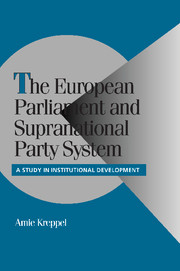Book contents
- Frontmatter
- Contents
- Figures
- Tables
- Acknowledgments
- 1 INTRODUCTION: THE EUROPEAN PARLIAMENT AND THE INSTITUTIONAL EVOLUTION OF LEGISLATURES
- 2 THEORIES OF LEGISLATIVE DEVELOPMENT AND THE EUROPEAN PARLIAMENT
- 3 THE DEVELOPMENT OF THE PARTY GROUP SYSTEM AND THE PARTY GROUPS
- 4 THE HISTORY OF THE EUROPEAN PARLIAMENT
- 5 THE INTERNAL DEVELOPMENT OF THE EUROPEAN PARLIAMENT: FROM COLLEGIALITY TO CONFLICT
- 6 THE DEVELOPMENT OF THE SUPRANATIONAL PARTY GROUP SYSTEM: CONFLICT AND COOPERATION IN THE COALITION FORMATION PROCESS
- 7 COOPERATION AND CO-DECISION: THE ROLE OF IDEOLOGY AND RULES
- 8 THE INTERNAL DEVELOPMENT OF THE SUPRANATIONAL PARTY GROUPS: AN ELUSIVE GOAL
- 9 CONCLUSIONS: UNDERSTANDING THE DEVELOPMENTAL PROCESS
- Appendices
- Bibliography
- Index
- Titles in the series
1 - INTRODUCTION: THE EUROPEAN PARLIAMENT AND THE INSTITUTIONAL EVOLUTION OF LEGISLATURES
Published online by Cambridge University Press: 18 December 2009
- Frontmatter
- Contents
- Figures
- Tables
- Acknowledgments
- 1 INTRODUCTION: THE EUROPEAN PARLIAMENT AND THE INSTITUTIONAL EVOLUTION OF LEGISLATURES
- 2 THEORIES OF LEGISLATIVE DEVELOPMENT AND THE EUROPEAN PARLIAMENT
- 3 THE DEVELOPMENT OF THE PARTY GROUP SYSTEM AND THE PARTY GROUPS
- 4 THE HISTORY OF THE EUROPEAN PARLIAMENT
- 5 THE INTERNAL DEVELOPMENT OF THE EUROPEAN PARLIAMENT: FROM COLLEGIALITY TO CONFLICT
- 6 THE DEVELOPMENT OF THE SUPRANATIONAL PARTY GROUP SYSTEM: CONFLICT AND COOPERATION IN THE COALITION FORMATION PROCESS
- 7 COOPERATION AND CO-DECISION: THE ROLE OF IDEOLOGY AND RULES
- 8 THE INTERNAL DEVELOPMENT OF THE SUPRANATIONAL PARTY GROUPS: AN ELUSIVE GOAL
- 9 CONCLUSIONS: UNDERSTANDING THE DEVELOPMENTAL PROCESS
- Appendices
- Bibliography
- Index
- Titles in the series
Summary
When the Parliamentary Assembly of the European Economic Community (EEC) was created in 1957 it was perceived as little more than a multinational chamber of Babel. It consisted of 142 Members appointed by the national legislators of the six Member States. It had no direct popular legitimacy, no control over the fledgling budget of the EEC, and no effective ability to influence legislative outcomes. The Assembly was in all senses a consultative body. But over the course of the last quartercentury the Parliamentary Assembly has evolved into a true European Parliament (EP). Directly elected since 1979 with partial (and increasing) control over the budget since 1975 and the ability to delay, amend, and even veto legislation, the European Parliament of today bears little resemblance to the Parliamentary Assembly of old. Today the EP deserves to be considered a “transformative” legislature capable of significantly impacting the decision-making and policy processes of the European Union (Polsby, 1975: 277–296).
This book examines the remarkable institutional development of the European Parliament since its inception in 1957, and particularly since it began its metamorphosis in earnest in the 1970s. It is not the actual increases to the powers of the EP that interest me, but rather the effect of these increases in terms of the internal institutional evolution of the EP as a legislature. In other words, the main question investigated is, What effect did exogenous increases in the powers and influence of the European Parliament have on its internal development?
- Type
- Chapter
- Information
- The European Parliament and Supranational Party SystemA Study in Institutional Development, pp. 1 - 12Publisher: Cambridge University PressPrint publication year: 2001



